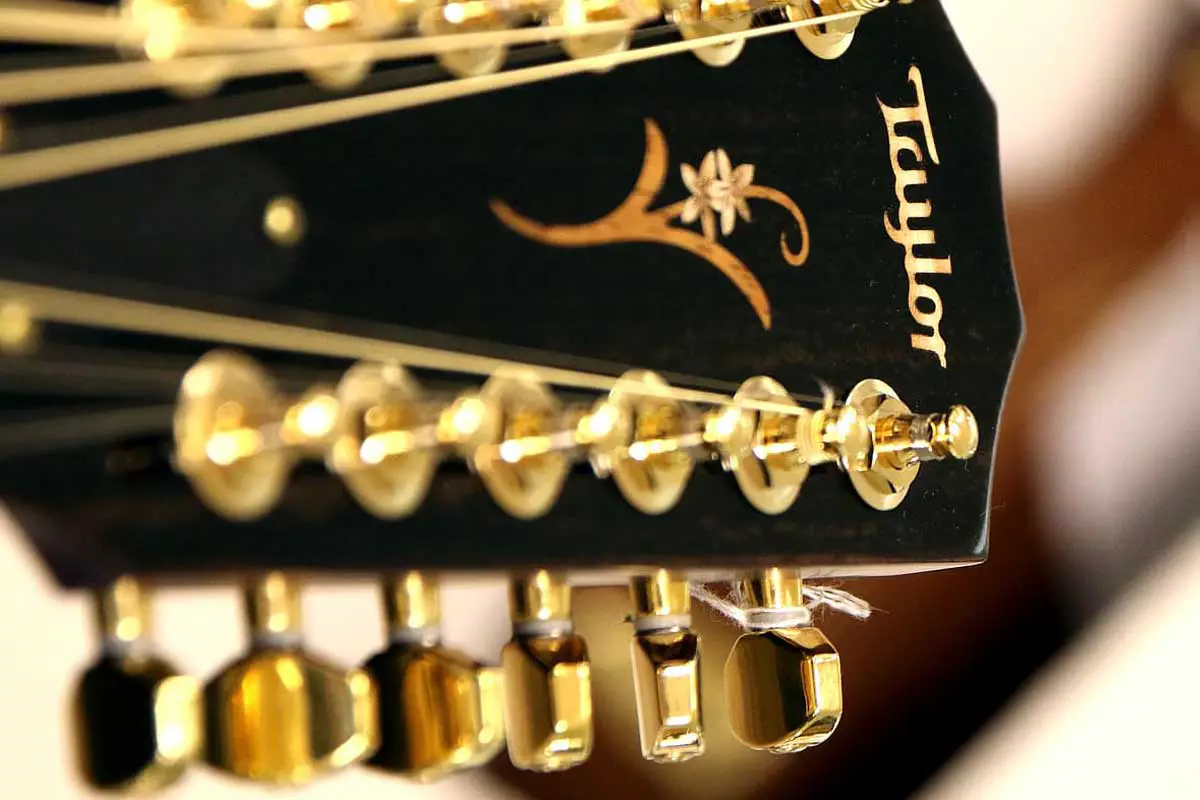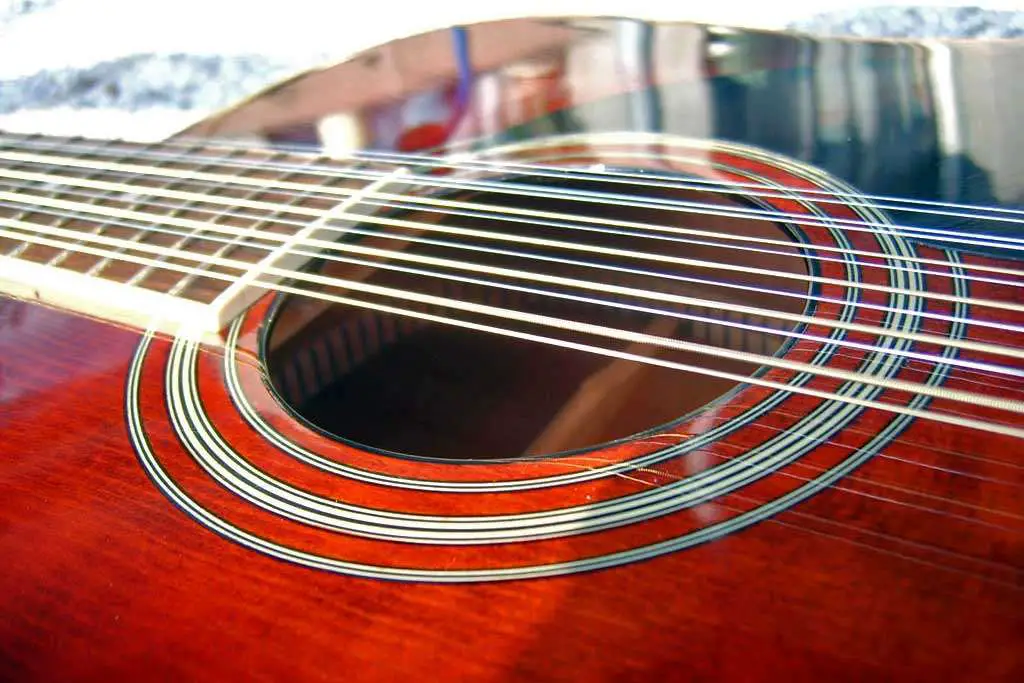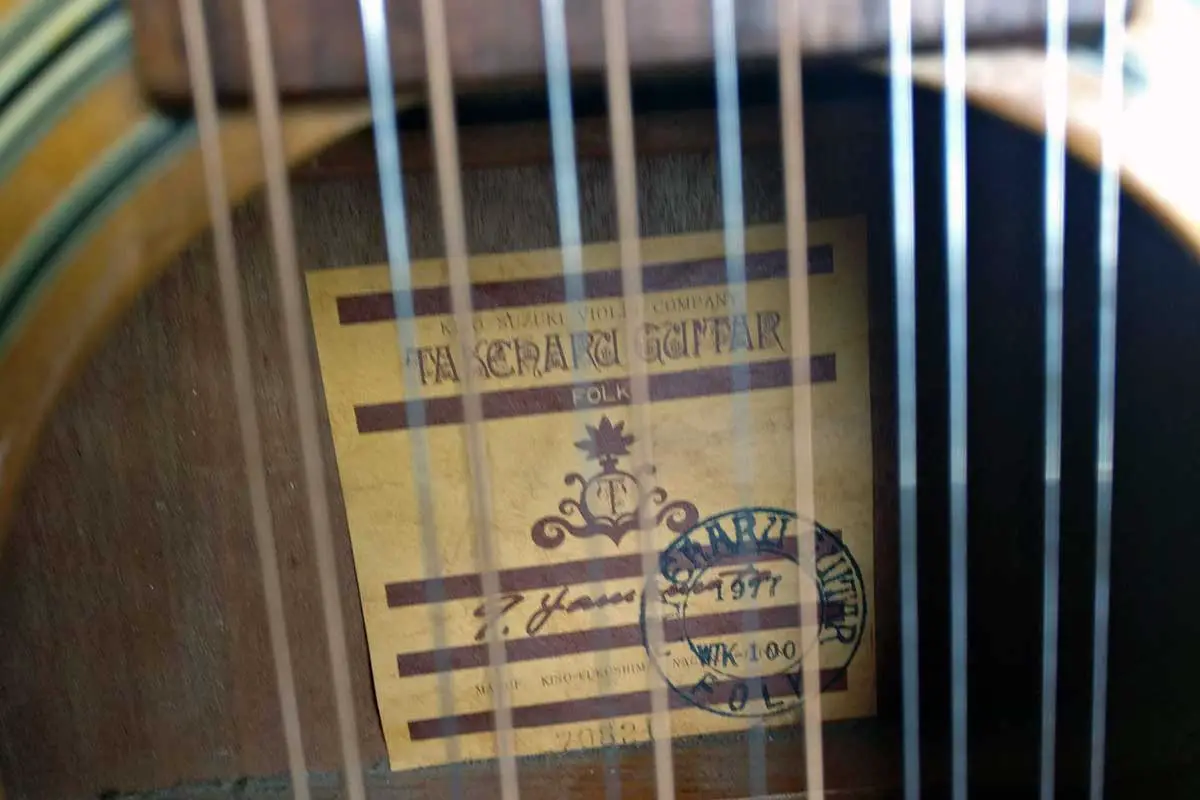Learning how to tune a 12 string guitar may seem like a task reserved for the patient or the meticulous, but once you understand the basics, it’s not much different from tuning a 6-string guitar. The biggest difference lies in the course pairs of strings, which means there are two strings close together that should be tuned to the same note on the lower four pairs, with the top two pairs tuned an octave apart.
To get your 12-string sounding harmonious and rich, you’ll want to tune the lower strings (E, A, D, G) in pairs to the same pitch, while the higher octave strings of the pair will be tuned to the same note, but one octave higher for the B and high E strings.
When you’re learning how to tune a 12 string guitar, remember that a good quality tuner is your best friend. This is because the doubled strings add more layers of vibrations, which can cause a bit of a tricky situation for your ear to differentiate.
Patience and a gentle touch are also essential; the strings, especially the thinner octave ones, are more prone to breaking if tuned too tightly. Embrace the challenge, and soon you’ll be strumming a beautifully tuned 12-string that fills the room with a lush, chorus-like sound that’s undeniably worth the effort!

Understanding 12 String Guitar Tuning
When you first lay eyes on a 12-string guitar, it’s like meeting a familiar friend with a hint of mystery. Think of it as a guitar on steroids. You’ve got twice the number of strings, packed in pairs, with one crucial twist: each pair has one string tuned an octave higher than its partner, except for the bass strings.
Tuning a 12-string: Start with the same E-A-D-G-B-e configuration you know from 6-string guitars, but remember, we’re dealing with pairs. For the lower four sets (E, A, D, G), you’ll tune the second string in each pair an octave up. This gives you that rich, chimey sound—a full chorus in a single strum.
Peg and Tension: Each string brings with it a tension to manage. So, let’s talk pegs. Your 12-string guitar will sport tuning pegs just like a 6-string, but double in number. Keep your turns gentle; the neck tension is real, and it’s key to keeping your instrument from feeling like a bow ready to shoot arrows.
Pairs of Strings: When tuning the paired strings, you might be concerned about snapping that high G. Breathe easy. It’s designed to soar high without a fuss. Gentle and steady does it—just like walking a tightrope without the risk of plummeting.
Look, no sugarcoating here, tuning a 12-string will test your patience. It’s a balancing act—twice the strings means double the tuning time. But once you’ve got the tension right and the octaves singing in harmony, the payoff is a sound as big as the sky on a clear night. Your 12-string isn’t just tuned; it’s a symphony at your fingertips.

How To Tune a 12 String Guitar
Tuning a 12-string guitar brings a lush, full sound to life, notably different from its 6-string cousin. Remember, patience is a virtue here, and a good tune makes all the difference in rich, resonant sound.
Standard Tuning Approach
Initiate the process with your low E string. Aim to match the standard tuning of E-A-D-G-B-e. You’re essentially tuning the guitar just like a 6-string, but with an additional string paired to each primary string. The pairs are either tuned in unison or an octave apart, creating that signature chorus effect. Consider using a chromatic tuner to get precise pitch accuracy.
- E (6th string) – Tune both E strings (the thicker one and the thinner one) in unison to the same low E note.
- A (5th string) – Align both A strings in unison as well.
- Keep going with D, G, B, and high e strings following the same pattern.
Tuning the Lower Octave Strings
When you reach the pairs for the D and G strings, things get interesting. You’ll tune these lower octave strings exactly one octave higher than their thicker counterparts. It adds sparkle to the low end—kinda like sugar, but for your ears.
- G (3rd string octave pair) – Tune this thinner string an octave higher than your standard G string.
- D (4th string octave pair) – This string also goes an octave up from the standard D string.
Tuning the Higher Octave Strings
The B and high E strings don’t need to stress about octaves; they enjoy the simple life tuned in unison. Just make sure they play nicely together at the same pitch, and you’ll have them singing like twins in a talent show.
- B (2nd string) and e (1st string) – Tune these pairs in unison, sharing the same pitch.
Now, with your 12-string guitar tuned, you can strum away to your heart’s content, bathing in the rich, shimmering sounds you’ve unleashed.
Troubleshooting Common Issues
When you’re tuning your 12-string guitar and run into problems like string buzz or stability issues, it can be a real bummer. Don’t fret! We’ll sort out these common gremlins, ensuring your guitar sounds spot-on.
Dealing with Buzzing Strings
Buzzing strings can really mess with your groove. First things first: check your guitar’s action. If the strings are too low, they’ll rub against the frets like a pesky mosquito in your tent. Give those strings some breathing room by adjusting the action. If that doesn’t fix it, inspect the neck. A slight truss rod tweak might be the game-changer. The goal is to get that buzz out of your life without calling pest control.
Fixing Tuning Stability Problems
If your axe is more wobbly than a jam session on a rowboat, we’ve got to tackle tuning stability. Start with the tuning keys; these little guys should be snugged up, not flopping over like they had a rough night out. Next, show some love to your guitar’s nut and bridge; sometimes, they grip the strings tighter than your grandma’s hugs. Lubricate them with a pencil (good ol’ graphite) or a proper nut lubricant. Lastly, remember to gently stretch your strings after a string change—like a warm-up before hitting the gym. Retune and you’ll be rock-solid.
Keep your strings fresh and retune regularly to maintain the crisp sound quality that makes your guitar sing like a bird in the morning. These tweaks ensure your 12-string guitar stays on point, so you can strum away and enjoy the lush, full sound you love.
12 String Guitar Songs

The 12-string guitar holds a special place in the pantheon of musical instruments, revered for its rich, choral-like sound that adds a unique dimension to any song. When employed skillfully, it infuses tracks with a lush, full-bodied resonance and a distinctive shimmering quality that can transform a simple melody into an auditory masterpiece.
The doubled strings of a 12-string guitar produce a natural chorus effect, elevating the music with a depth and complexity that is difficult to replicate with a standard 6-string. The following tracks are prime examples of how the 12-string guitar’s enchanting sound can leave an indelible mark on the listener’s experience.
- “Hotel California” by the Eagles: The iconic intro and solos of this classic rock anthem are played on a 12-string guitar, giving it a rich, full sound that has become one of the most recognizable in rock history.
- “Wish You Were Here” by Pink Floyd: The 12-string guitar is used here to create a haunting and melodic intro that sets the tone for this introspective and emotionally charged song.
- “Over the Hills and Far Away” by Led Zeppelin: Jimmy Page’s use of a 12-string guitar in this track adds a layer of complexity and brightness, complementing the song’s dynamic shifts from soft acoustic to hard electric sounds.
- “Mr. Tambourine Man” by The Byrds: The jangly, bright sound of the 12-string guitar riff in this song helped define the folk-rock genre and continues to influence the sound of jangle pop today.

Other Guitar Tunings To Explore
Eb Half Step Down Tuning Eb-Ab-Db-Gb-Bb-Eb
Frequently Asked Questions
In this section, we tackle some of the most common queries that guitarists have when tuning their 12-string guitar, from tools of the trade to specific challenges you might encounter.
What is the correct process for tuning a 12-string guitar for beginners?
Tuning a 12-string guitar for beginners involves tuning the octave strings to match their corresponding main strings, except for the bass strings which are tuned in unison. Start with the 6th string pair and work your way to the 1st, using a tuner for accuracy.
What’s the 12 string guitar string order?
The 12-string guitar string order typically pairs a standard tuned string with a higher octave counterpart for the E, A, D, and G strings, while the B and high E strings are paired with unison strings. The sequence from lowest pitch to highest is eE aA dD gG BB EE.
Which are the best apps or tools to use for tuning a 12-string guitar?
The best tools for tuning a 12-string guitar include clip-on tuners like Snark or apps like GuitarTuna that are designed to handle the unique tuning of a 12-string.
What are the tuning steps using a Snark tuner or similar device for a 12-string guitar?
For tuning with a Snark tuner, clip it onto the headstock, turn it on, pluck each string, and adjust until the display shows the correct note for each string pair—it’s that straightforward.
How do the string pairs on a 12-string guitar need to be ordered during tuning?
The string pairs should be tuned with the main (lower octave) string first, followed by the octave string, except for the bass pairs, which are both tuned to the same note.
Is there a difference in the tuning process for an acoustic versus an electric 12-string guitar?
The tuning process for an acoustic and electric 12-string guitar is essentially the same, though electric guitars may be more sensitive to intonation adjustments.
Are there any common challenges or tips to consider when tuning a 12-string guitar?
Common challenges when tuning a 12-string include ensuring accuracy with the octave strings and maintaining stable tuning. A tip is to tune up to the desired pitch rather than down to it to help the strings stay in tune longer.
